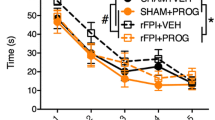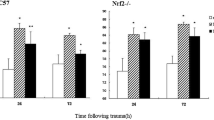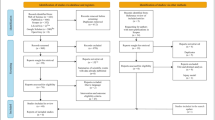Abstract
Progesterone has been studied extensively in preclinical models of adult traumatic brain injury (TBI), and has advanced to clinical trials in adults with TBI. However, there are very few preclinical studies in pediatric TBI models investigating progesterone for neuroprotection. Immature male and female rats (postnatal day, PND 17–21) underwent controlled cortical impact (CCI) to the left parietal cortex. Rats received either progesterone (10 mg/kg) at 1 h (i.p.) and 6 h (s.c.) after TBI or vehicle (22.5 % cyclohexdrin), and were compared to naïve, age-matched littermates. At 24 h after CCI, brain mitochondria were isolated from the ipsilateral hemisphere. Active (State 3) and resting (State 4) mitochondrial respiration were measured, and mitochondrial respiratory control ratio (RCR, State 3/State 4) was determined. Total mitochonidral glutathione content was measured. A separate group of rats were studied for histology, and received progesterone or vehicle every 24 h (s.c.) for 7 days. In male rats, TBI reduced mitochondrial RCR, and progesterone preserved mitochondrial RCR. This improvement of RCR was predominantly through significant decreases in State 4 respiratory rates. In female rats, post-injury treatment with progesterone did not significantly improve mitochondrial RCR. Normal (uninjured) male rats had lower mitochondrial glutathione content than normal female rats. After TBI, progesterone prevented loss of mitochondrial glutathione in male rats only. Tissue loss was reduced in progesterone treated female rats at 7d after CCI. Future studies will be directed at correlation with neurologic outcome testing. These preclinical studies could provide information for planning future clinical trials of progesterone treatment in children with TBI.






Similar content being viewed by others
References
Babikian T, Asarnow R (2009) Neurocognitive outcomes and recovery after pediatric TBI: meta-analytic review of the literature. Neuropsychology 23:283–96
Bayir H, Kagan VE, Tyurina YY et al (2002) Assessment of antioxidant reserves and oxidative stress in cerebrospinal fluid after severe traumatic brain injury in infants and children. Pediatr Res 51:571–8
Baykara B, Aksu I, Buyuk E et al (2013) Progesterone treatment decreases traumatic brain injury induced anxiety and is correlated with increased serum IGF-1 levels; prefrontal cortex, amygdala, hippocampus neuron density; and reduced serum corticosterone levels in immature rats. Biotech Histochem 88:250–7
Bramlett HM, Dietrich WD (2001) Neuropathological protection after traumatic brain injury in intact female rats versus males or ovariectomized females. J Neurotrauma 18:891–900
Catroppa C, Godfrey C, Rosenfeld JV, Hearps SS, Anderson VA (2012) Functional recovery ten years after pediatric traumatic brain injury: outcomes and predictors. J Neurotrauma 29:2539–47
Chen G, Shi J, Jin W et al (2008) Progesterone administration modulates TLRs/NF-kappaB signaling pathway in rat brain after cortical contusion. Ann Clin Lab Sci 38:65–74
Cutler SM, VanLandingham JW, Murphy AZ, Stein DG (2006) Slow-release and injected progesterone treatments enhance acute recovery after traumatic brain injury. Pharmacol Biochem Behav 84:420–8
De Nicola AF, Labombarda F, Deniselle MC et al (2009) Progesterone neuroprotection in traumatic CNS injury and motoneuron degeneration. Front Neuroendocrinol 30:173–87
Du L, Bayir H, Lai Y et al (2004) Innate gender-based proclivity in response to cytotoxicity and programmed cell death pathway. J Biol Chem 279:38563–70
Fiskum G (2000) Mitochondrial participation in ischemic and traumatic neural cell death. J Neurotrauma 17:843–55
Garcia-Estrada J, Luquin S, Fernandez AM, Garcia-Segura LM (1999) Dehydroepiandrosterone, pregnenolone and sex steroids down-regulate reactive astroglia in the male rat brain after a penetrating brain injury. Int J Dev Neurosci 17:145–51
Gilland E, Puka-Sundvall M, Hillered L, Hagberg H (1998) Mitochondrial function and energy metabolism after hypoxia-ischemia in the immature rat brain: involvement of NMDA-receptors. J Cereb Blood Flow Metab 18:297–304
Gilmer LK, Roberts KN, Joy K, Sullivan PG, Scheff SW (2009) Early mitochondrial dysfunction after cortical contusion injury. J Neurotrauma 26:1271–80
Goss CW, Hoffman SW, Stein DG (2003) Behavioral effects and anatomic correlates after brain injury: a progesterone dose–response study. Pharmacol Biochem Behav 76:231–42
He J, Evans CO, Hoffman SW, Oyesiku NM, Stein DG (2004) Progesterone and allopregnanolone reduce inflammatory cytokines after traumatic brain injury. Exp Neurol 189:404–12
Holtzman D, Moore CL (1973) Oxidative phosphorylation in immature rat brain mitochondria. Biol Neonate 22:230–42
Holtzman D, Moore CL (1975) Respiration in immature rat brain mitochondria. J Neurochem 24:1011–5
Keenan HT, Bratton SL (2006) Epidemiology and outcomes of pediatric traumatic brain injury. Dev Neurosci 28:256–63
Kilbaugh TJ, Bhandare S, Lorom DH, Saraswati M, Robertson CL, Margulies SS (2011) Cyclosporin A preserves mitochondrial function after traumatic brain injury in the immature rat and piglet. J Neurotrauma 28:763–74
Konkle AT, McCarthy MM (2011) Developmental time course of estradiol, testosterone, and dihydrotestosterone levels in discrete regions of male and female rat brain. Endocrinology 152:223–35
Lifshitz J, Sullivan PG, Hovda DA, Wieloch T, McIntosh TK (2004) Mitochondrial damage and dysfunction in traumatic brain injury. Mitochondrion 4:705–13
Manole MD, Tehranian-DePasquale R, Du L, Bayir H, Kochanek PM, Clark RS (2011) Unmasking sex-based disparity in neuronal metabolism. Curr Pharm Des 17:3854–60
Martensson J, Lai JC, Meister A (1990) High-affinity transport of glutathione is part of a multicomponent system essential for mitochondrial function. Proc Natl Acad Sci U S A 87:7185–9
O’Connor CA, Cernak I, Vink R (2005) Both estrogen and progesterone attenuate edema formation following diffuse traumatic brain injury in rats. Brain Res 1062:171–4
O’Connor CA, Cernak I, Johnson F, Vink R (2007) Effects of progesterone on neurologic and morphologic outcome following diffuse traumatic brain injury in rats. Exp Neurol 205:145–53
Ozacmak VH, Sayan H (2009) The effects of 17beta estradiol, 17alpha estradiol and progesterone on oxidative stress biomarkers in ovariectomized female rat brain subjected to global cerebral ischemia. Physiol Res 58:909–12
Pan DS, Liu WG, Yang XF, Cao F (2007) Inhibitory effect of progesterone on inflammatory factors after experimental traumatic brain injury. Biomed Environ Sci 20:432–8
Patel SP, Sullivan PG, Pandya JD et al (2014) N-acetylcysteine amide preserves mitochondrial bioenergetics and improves functional recovery following spinal trauma. Exp Neurol 257:95–105
Puka-Sundvall M, Wallin C, Gilland E et al (2000) Impairment of mitochondrial respiration after cerebral hypoxia-ischemia in immature rats: relationship to activation of caspase-3 and neuronal injury. Brain Res Dev Brain Res 125:43–50
Robertson CL, Puskar A, Hoffman GE, Murphy AZ, Saraswati M, Fiskum G (2006) Physiologic progesterone reduces mitochondrial dysfunction and hippocampal cell loss after traumatic brain injury in female rats. Exp Neurol 197:235–43
Robertson CL, Saraswati M, Fiskum G (2007) Mitochondrial dysfunction early after traumatic brain injury in immature rats. J Neurochem 101:1248–57
Robertson CL, Scafidi S, McKenna MC, Fiskum G (2009) Mitochondrial mechanisms of cell death and neuroprotection in pediatric ischemic and traumatic brain injury. Exp Neurol 218:371–80
Roof RL, Hall ED (2000) Gender differences in acute CNS trauma and stroke: neuroprotective effects of estrogen and progesterone. J Neurotrauma 17:367–88
Roof RL, Zhang Q, Glasier MM, Stein DG (1993a) Gender-specific impairment on Morris water maze task after entorhinal cortex lesion. Behav Brain Res 57:47–51
Roof RL, Duvdevani R, Stein DG (1993b) Gender influences outcome of brain injury: progesterone plays a protective role. Brain Res 607:333–6
Roof RL, Duvdevani R, Braswell L, Stein DG (1994) Progesterone facilitates cognitive recovery and reduces secondary neuronal loss caused by cortical contusion injury in male rats. Exp Neurol 129:64–9
Roof RL, Duvdevani R, Heyburn JW, Stein DG (1996) Progesterone rapidly decreases brain edema: treatment delayed up to 24 h is still effective. Exp Neurol 138:246–51
Roof RL, Hoffman SW, Stein DG (1997) Progesterone protects against lipid peroxidation following traumatic brain injury in rats. Mol Chem Neuropathol 31:1–11
Sayeed I, Stein DG (2009) Progesterone as a neuroprotective factor in traumatic and ischemic brain injury. Prog Brain Res 175:219–37
Sayeed I, Parvez S, Wali B, Siemen D, Stein DG (2009) Direct inhibition of the mitochondrial permeability transition pore: a possible mechanism for better neuroprotective effects of allopregnanolone over progesterone. Brain Res 1263:165–73
Shimamura K, Sugino N, Yoshida Y, Nakamura Y, Ogino K, Kato H (1995) Changes in lipid peroxide and antioxidant enzyme activities in corpora lutea during pseudopregnancy in rats. J Reprod Fertil 105:253–7
Smith SS (1991) Progesterone administration attenuates excitatory amino acid responses of cerebellar Purkinje cells. Neuroscience 42:309–20
Smith SS, Waterhouse BD, Chapin JK, Woodward DJ (1987) Progesterone alters GABA and glutamate responsiveness: a possible mechanism for its anxiolytic action. Brain Res 400:353–9
Starkov AA, Fiskum G, Chinopoulos C et al (2004) Mitochondrial alpha-ketoglutarate dehydrogenase complex generates reactive oxygen species. J Neurosci 24:7779–88
Stein DG (2008) Progesterone exerts neuroprotective effects after brain injury. Brain Res Rev 57:386–97
Stein DG, Hoffman SW (2003) Estrogen and progesterone as neuroprotective agents in the treatment of acute brain injuries. Pediatr Rehabil 6:13–22
Subramanian M, Pusphendran CK, Tarachand U, Devasagayam TP (1993) Gestation confers temporary resistance to peroxidation in the maternal rat brain. Neurosci Lett 155:151–4
Sullivan PG, Keller JN, Bussen WL, Scheff SW (2002) Cytochrome c release and caspase activation after traumatic brain injury. Brain Res 949:88–96
Sullivan PG, Rabchevsky AG, Waldmeier PC, Springer JE (2005) Mitochondrial permeability transition in CNS trauma: cause or effect of neuronal cell death? J Neurosci Res 79:231–9
Tilford JM, Aitken ME, Anand KJ et al (2005) Hospitalizations for critically ill children with traumatic brain injuries: a longitudinal analysis. Crit Care Med 33:2074–81
Tsuji M, Taguchi A, Ohshima M, Kasahara Y, Ikeda T (2012) Progesterone and allopregnanolone exacerbate hypoxic-ischemic brain injury in immature rats. Exp Neurol 233:214–20
Uysal N, Baykara B, Kiray M et al (2013) Combined treatment with progesterone and magnesium sulfate positively affects traumatic brain injury in immature rats. Turk Neurosurg 23:129–37
VanLandingham JW, Cutler SM, Virmani S et al (2006) The enantiomer of progesterone acts as a molecular neuroprotectant after traumatic brain injury. Neuropharmacology 51:1078–85
Verweij BH, Muizelaar JP, Vinas FC, Peterson PL, Xiong Y, Lee CP (1997) Mitochondrial dysfunction after experimental and human brain injury and its possible reversal with a selective N-type calcium channel antagonist (SNX-111). Neurol Res 19:334–9
Verweij BH, Muizelaar JP, Vinas FC, Peterson PL, Xiong Y, Lee CP (2000) Impaired cerebral mitochondrial function after traumatic brain injury in humans. J Neurosurg 93:815–20
Vink R, Nimmo AJ (2009) Multifunctional drugs for head injury. Neurotherapeutics 6:28–42
Wallin C, Puka-Sundvall M, Hagberg H, Weber SG, Sandberg M (2000) Alterations in glutathione and amino acid concentrations after hypoxia-ischemia in the immature rat brain. Brain Res Dev Brain Res 125:51–60
Walson KH, Tang M, Glumac A et al (2011) Normoxic versus hyperoxic resuscitation in pediatric asphyxial cardiac arrest: effects on oxidative stress. Crit Care Med 39:335–43
Wechsler B, Kim H, Gallagher PR, DiScala C, Stineman MG (2005) Functional status after childhood traumatic brain injury. J Trauma 58:940,9, discussion 950
Wright DW, Kellermann AL, Hertzberg VS et al (2007) ProTECT: a randomized clinical trial of progesterone for acute traumatic brain injury. Ann Emerg Med 49:391–402, 402.e1-2
Xiao G, Wei J, Yan W, Wang W, Lu Z (2008) Improved outcomes from the administration of progesterone for patients with acute severe traumatic brain injury: a randomized controlled trial. Crit Care 12:R61
Xiong Y, Peterson PL, Verweij BH, Vinas FC, Muizelaar JP, Lee CP (1998) Mitochondrial dysfunction after experimental traumatic brain injury: combined efficacy of SNX-111 and U-101033E. J Neurotrauma 15:531–44
Xiong Y, Peterson PL, Lee CP (1999) Effect of N-acetylcysteine on mitochondrial function following traumatic brain injury in rats. J Neurotrauma 16:1067–82
Yao XL, Liu J, Lee E, Ling GS, McCabe JT (2005) Progesterone differentially regulates pro- and anti-apoptotic gene expression in cerebral cortex following traumatic brain injury in rats. J Neurotrauma 22:656–68
Yeates KO, Swift E, Taylor HG et al (2004) Short- and long-term social outcomes following pediatric traumatic brain injury. J Int Neuropsychol Soc 10:412–26
Acknowledgments
Department of Anesthesiology and Critical Care Medicine, Johns Hopkins University School of Medicine
Conflict of interest
None
Author information
Authors and Affiliations
Corresponding author
Rights and permissions
About this article
Cite this article
Robertson, C.L., Saraswati, M. Progesterone protects mitochondrial function in a rat model of pediatric traumatic brain injury. J Bioenerg Biomembr 47, 43–51 (2015). https://doi.org/10.1007/s10863-014-9585-5
Received:
Accepted:
Published:
Issue Date:
DOI: https://doi.org/10.1007/s10863-014-9585-5




